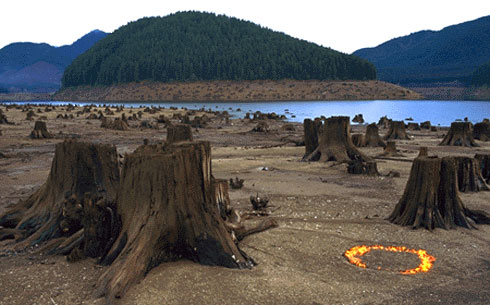

To find out more about the fascinating age of
dam removal contact American Rivers.
If you would like more information about ongoing efforts to protect the
Willamette National Forest contact: Oregon
Natural Resources Council.
Mt. Hood National Forest
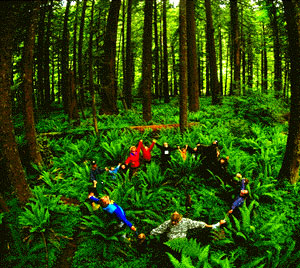
Contact Secrets to learn more about their "SECRETS of Our Forest Home Education" program--a science and wonder-based environmental education model that can be applied to all ecosystems.
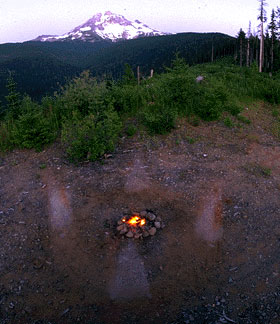
Ghost Dance Circle. On the log deck of a ten-year-old clearcut, Prescott University Dancer Professor, Liz Fallor dances around a fire ring, pausing at each of the four directions to welcome the slowly recovering forest. With the old forest missing, Mt. Hood looms in the background, a beautiful view yes....but not the one nature intended here.
MOUNT HOOD PROPOSAL: The Forest Service released a proposal to protect areas of the Mount Hood National Forest by limiting hiking and camping access, according to the Oregon Wildlife Federation (OWF). However, the environmental community recommends that the best way to reduce pressure on the forests is to designate more wilderness areas and OWF is calling for the entire Mount Hood National Forest to be one of those areas. The Forest Service is refusing to participate in a public forum that might expose their proposal to criticism by the public. "The Forest Service is currently destroying wilderness areas faster than you imagine," said Joe Keating of OWF. "The recreational needs of our community are not served by destroying our watersheds and ancient forests."
For information on ongoing efforts to protect
the remaining unprotected old-growth in Mt. Hood National Forest contact: Oregon
Natural Resources Council.
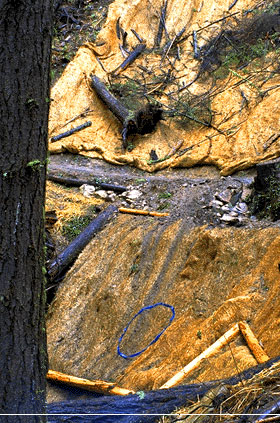
For more information on the Rogue River National
Forest, contact Headwaters.
Siuslaw National Forest
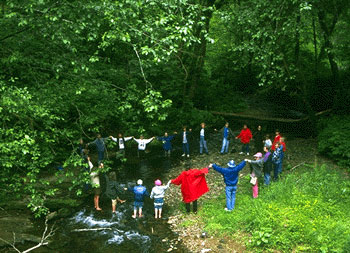
Salmon Ring.
To
celebrate the return of the Coho to a creek recieving ongoing restoration
work, local activists young and old formed a ring across this bend in the
river.The Siuslaw NF encompasses approximately 630,000 acres in Oregonís
Coast Range Bioregion. It was once one of the major timber producers in
the Northwest but as a result of the Northwest Forest Plan and the need
to protect Theatened and Endangered Species like the Coastal Coho Salmon
and Steelhead, timber production has dropped to approximately 8 Million
Bd Feet which comes from commercial thinning of existing plantations.
The Siuslaw NF may be one of the more progressive National Forests in that it appears to moving in the direction of a 'Protection and Restoration Strategy by watershed' which many of the local activists have been advocating and which has been mandated for the Coast Range by the NW Forest Plan. Local activists must hold the federal and state agencies accountable to their responsibility to protect and restore T & E species and salmon populations. Participation at the local and bioregional level is crucial if we are going to be successful!!
For specific information on the Siuslaw contact:
Coast Range Association
Chuck Willer
PO Box 2250
Corvallis, OR 97339
541-758-0255
541-752-3146 Fax
Oregon Natural Resources Council
Ken Rait
5825 N. Greely Ave
Portland, OR 97215
503-283-6343
503-283-0756 Fax
Corvallis Audubon Society
Mary Derr
PO Box 2430
Corvallis, OR 97339
541-737-5363
Siskiyou National
Forest

Lou Gold's Bald Mt.Wheel.The contemporary on-the-ground forest activist movement began in 1983 when Earth First! and local activists from southern Oregon planted themselves in front of the bulldozers on the Bald Mountain road in the Siskiyou National Forest. Following that seminal controversy, Lou Gold hiked back into the North Kalmiopsis wilderness to begin twelve consecutive seasons of summer-long vigils where he becameme the caretaker of the the prayer circle on Bald Montain. At the end of his second season on the mountain, he wrote:
"By Solstice, the Medicine Wheel had been fully restored. Brightly colored flags waved in the strong breeze and fresh strings of tobacco ties decorated the flagpoles. On Solstice we spent twenty-four hours within the prayer circle, fasting and remaining in silence. The night before, we had gone to sleep blanketed by wet clouds that hovered about the mountaintop. At dawn a patch of blue sky opened directly above us. All day we watched as the sun burned off the moisture, and mountain ridges rose out of the low-lying fog and the clear sky spread toward the coast. It felt as if a light or energy was radiating outward from Bald Mountain."
"Everything had a quality of sacredness on that longest day. We walked the circle casting tobacco to the winds. We burned cedar and sage in the fire pit near the centerpole. We prayed for the trees, gave thanks for the many wonders of this existence, and thought of loved ones near and far. The circle was complete: we stood humbly in the midst of a great natural harmony and the world, for the moment, seemed in order. Then I had a vision of many prayer circles, forest and mountain shrines throughout our region - places of power and renewal, of peace and pilgrimage. They would be, like Bald Mountain, safe spotsin confusing times, rallying points and sanctuaries for those wholove this earth and her peoples."
The Zero Circles campaign now pursues a similar vision in National Forests across the nation.
For over a decade Lou has traveled the country with his very popular Ancient Forest Slideshow and earned the title of Hermit-With-the-Most-Frequent-Flyer-Miles. The Siskiyou Project of which he is a founding member has become one of the most effective grassroots forest activist networks in the U.S. Please visit their webpage at www.siskiyou.org For a full story of Lou Gold's Bald Mt., www.siskiyou.org/lou/journals/vigil.html

Rogue River Ring.
This posterized version of a photo sent in by an activist shows the
rock circle he built in a quiet pool near his camp on the Rogue River.
The Rogue National Wild and Scenic River is the most popular whitewater
rafting trip in Oregon. While much of this river flows through wilderness,
most trips conclude in a region marred with clearcut mountain sides spoiling
the wildness of the experience for many. Recreation in our National Forests
contributes 30 times more jobs and income to the economy than does logging
these lands--one of many reasons to end the federal timber sales program,
i.e. "Zero Cut."

Since BLM manages considerable lower elevation forests (lower than the forest service) they own some of the biggest and best public ancient forests. They've been aggressively clearcutting them for years, and now they are looking at less than 30 years before they have all the available old-growth clearcut (according to the USFWS). It's hard to imagine, just 30 years left of these forests that have taken thousands of years to evolve and contain centuries old trees. The Class of 98 sale is 204 acres, most of it old growth. 7million board feet are planned to be cut. . . 1,400 log trucks. Ending commerical logging on public lands would stop this and similar sales.
For information on forests in the Umpqua Watershed,
contact the Umpqua
Watershed, Inc.
Medford District--BLM
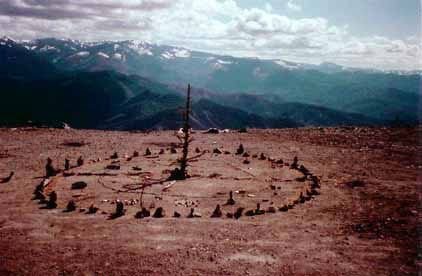
Applegate Zero, 2003.
This
large circle was built by community members in the Little Applegate Watershed,
at the edge of the proposed Dakubetede Wilderness. It was constructed in
response to the BLM's plans to log over 30,000 acres in the watershed and
surrounding area in the next few years. The Little Applegate Watershed
is a diverse and beautiful place, unique in its aridity due to the rain
shadow cast by the snowy Siskiyou crest in the background. Here, on a high,
south-facing slope, junipers, sagebrush, and mountain mahogany live in
steep, open grasslands. In the drainage below live the rare and endemic
siskiyou birch, giant ponderosa pines and Douglas fir, ancient pacific
yews, and even an odd redwood! This inspiring place is considered sacred
by many present-day residents and visitors, and was surely sacred to the
humans who lived here before European colonization.
Constructed in a gravel pit
guarded for logging road material, this community mandala represents our
intention to heal the existing wounds before we further pillage our magnificent
public lands.
If you would like to help save
this area, please write to Rich Drehobl, Ashland Field Manager, Medford
District BLM, 3040 Biddle Rd., Medford, OR 97504. Tell him to cancel the
Bobar, Bald Lick, and Prince Castor timber sales. You may also contact
TELAV (Threatened and Endangered Little Applegate Valley) at www.deepwild.org,
(541-899-1712), telav@deepwild.org, POB 1330, Jacksonville, OR 97530.